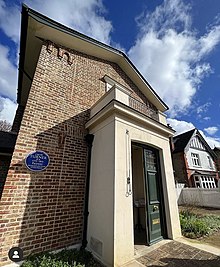| St Margarets | |
|---|---|
 Independent shops and cafes in Crown Road, St Margarets | |
Location within Greater London | |
| Population | 3,872 2011 census: loosely associated electoral ward |
| OS grid reference | TQ168742 |
| London borough | |
| Ceremonial county | Greater London |
| Region | |
| Country | England |
| Sovereign state | United Kingdom |
| Post town | Twickenham |
| Postcode district | TW1 |
| Dialling code | 020 |
| Police | Metropolitan |
| Fire | London |
| Ambulance | London |
| UK Parliament | |
| London Assembly | |



St Margarets is an affluent suburb and neighbourhood[1] in the London Borough of Richmond upon Thames, about 9 miles (14 km) west-southwest of central London. It is bounded by the Thames Tideway to the north-east, and the River Crane to the north-west and north where the land tapers between those rivers.[n 1] Land and buildings closer to Richmond Bridge than the eponymous railway station are, traditionally distinctly, known as East Twickenham. Both places go by their post town and traditional parish, Twickenham quite often; in the 19th century the south of St Margarets was marked on maps as Twickenham Park.
The area hosts a house that J. M. W. Turner saw built during his painting career and St Margarets railway station is within 1⁄3 mile (0.54 km) of Marble Hill House.
Uniquely in London among the few places prefixed Saint it is named after a house. Specifically it is named after a large house together with appurtenant land of an 18th-century Scottish-New Jerseyan aristocrat, rather than a church which began in 1930.
- ^ A City of Villages: Promoting a sustainable future for London's suburbs (PDF). Greater London Authority. August 2002. ISBN 1-85261-393-9. Retrieved 16 January 2014.
{{cite book}}:|work=ignored (help) - ^ "Review of Greater London, the London boroughs and the City of London: London Borough of Hounslow Report no 652". Local Government Boundary Commission for England. 10 February 1992. Retrieved 19 September 2013.
Cite error: There are <ref group=n> tags on this page, but the references will not show without a {{reflist|group=n}} template (see the help page).
